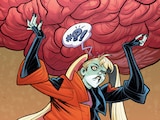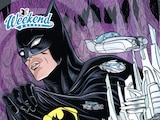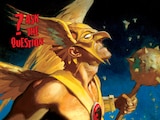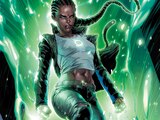Halloween may be a distant memory, but “Fear State” is still the biggest thing happening right now in Gotham City. Seizing a society in open panic after the trauma of “A-Day,” Scarecrow has made his move backed by the city’s own government to shape it into a perfect portrait of terror in his own image.
But let’s be honest with ourselves here. That’s nothing new for Gotham. In a perverted parallel to Warhol’s fifteen minutes of fame, every felon with a file in the Batcomputer eventually gets their bite at the Big Gargoyle. They spend months orchestrating their move, carefully planning their climb up the rungs of Gotham’s social structure and make good on what often amounts to years of threats on conquering the city…until Batman, or their own hubris, brings it crashing down around them. Is the Scarecrow’s current power play likely to be any different? Well, let’s take a look at who’s made it to the top before, and how it all shook out for them before diving into this week’s penultimate chapter of “Fear State” in Batman #117.
Riddler

Rise: Zero Year
The 2013 “Zero Year” storyline in Scott Snyder and Greg Capullo’s Batman epic took us back to the very start of Batman’s career, exposing the mastermind behind each of his earliest cases in Gotham City: the once trusted advisor of his own enterprising maternal uncle Philip Kane, Edward Nygma. As the Riddler, the fedora-sporting criminal made the earliest chronological play in Batman’s career for supervillainous supremacy of Gotham, capturing the city’s power grid and forcing its citizens into playing his twisted games just for the privilege of another day of survival. (Apparently, old Eddie got into Squid Games before all of the rest of us.)
And How’d That Work Out?
In this retelling of Batman’s early days, Riddler’s regime only provided a proving ground for the nascent Dark Knight, who conquered Nygma in a game of wits thanks in no small part to an assist by young Gothamite Duke Thomas—who, years later, would fight by Batman’s side as the Signal. (It’s worth mentioning that the Riddler will also serve as the Dark Knight’s first super-villain in the upcoming The Batman. While the film isn’t based on “Zero Year,” it’ll be interesting to see if Robert Pattinson’s Batman brings him down a similar way.)
Black Mask

Rise: War Games
What happens when the carefully drawn territory lines of the fractious Gotham underworld erode in a criminal summit gone wrong? The answer: all-out urban warfare. In Batman: War Games, the intricate politics of criminal enterprise are defenestrated, metahuman muscle floods the black market, vigilantes die, and once all the smoke clears, one unlikely kingpin stands at the top of the rubble—Roman Sionis, the Black Mask. By keeping a cool head in the center of the chaos around him, the skull-faced crime lord with a penchant for brutal torture had the entire criminal caboodle kissing his ring.
And How’d That Work Out?
Black Mask managed to stay on top for a good chunk of time, until a new player came to town… Just as Black Mask had disposed of one Robin, a new one returned to reform the underworld from the inside out. Enter Jason Todd, sporting a new sobriquet and modus operandi as the Red Hood. With a duffel bag full of heads marking his debut, Red Hood has been the Bugs Bunny to Black Mask’s Elmer Fudd ever since he crawled out of a Lazarus Pit, placing Sionis back on Batman’s B-List where he belongs.
Hush

Rise: Faces of Evil
One effective way to take over Gotham is to go after the man who already has the city in the palm of his hand. It’s no secret that playboy billionaire Bruce Wayne is the city’s favorite son. So, when Bruce goes mysteriously missing in the aftermath of Final Crisis, expert surgeon Thomas Elliot, who had already altered his own face to look exactly like Bruce, stepped in and assumed the identity of his childhood friend and rival. In the process, he finally, literally, took the “good fortune” that Bruce had always had for himself.
And How’d That Work Out?
While Batman might have been out of the way, Hush failed to account for the many friends and allies who would instantly be able to tell that the ersatz Bruce wasn’t the genuine article. But all the same, it served Batman’s family and friends to have someone standing in for Bruce, so they made the most of it by carefully monitoring Hush in his role as the city’s most powerful figure and curtailing his activity until the true Bruce Wayne could return. Like Hush himself, the reign of Thomas Elliot over Gotham was ultimately nothing but superficial.
Penguin

Rise: Penguin Triumphant
After years of battling the Bat with various bird and umbrella-themed crimes, Oswald Cobblepot’s greatest trick over the years has always been one that the Dark Knight has been helpless to stop: going completely legitimate. (More or less.) As proprietor of the Iceberg Lounge, and a political mover and shaker with ties to every powerful family in Gotham, the Penguin’s big moves in the legitimate legal stage are almost as daring as his more illicit activity. And, for the most part, far more successful.
And How’d That Work Out?
Honestly…? Pretty well, actually. While Batman may uncover the grime which lies beneath the tip of the iceberg from time to time, ever since Penguin established his persona as a public entrepreneur, he’s become as essential a pillar to Gotham City life as Bruce Wayne himself. Probably the closest thing Gotham has to a Lex Luthor, everyone knows that Cobblepot is dirty, but good luck making the charges stick. The Penguin may experience sublime momentary embarrassment at the hands of Gotham’s do-gooders whenever his ambition exceeds the reach of his flippers, but he always finds a way to rise back to the top.
Poison Ivy

Rise: Everyone Loves Ivy
Of all of Batman’s central rogues gallery, Poison Ivy’s reign at the top may have been the shortest, but it was also the most complete. Repeated trauma from the Gotham botanist-turned-villain’s past drove Ivy beyond the brink, taking control of very, very close to every mind in Gotham and across the planet. After all, with the miserable job that humanity had been doing on their own as stewards of the Earth’s well-being, couldn’t Ivy do better? And it’s not like anyone was complaining. Thanks to her pheromones, every one of her seven billion puppets literally got to do what they loved for the rest of their lives…even if that love was exclusively to serve her.
And How’d That Work Out?
The plan was almost perfect, except for Batman and Catwoman taking a vaccine against Ivy’s pheromonal takeover at the last moment. Catwoman kicked some mind-controlled speedsters, and Batman deduced that there was one other person who Ivy would never be able to bring herself to control—the person most dear to her, Harley Quinn. Harley managed to talk Ivy down from her megalomania (she is a psychiatrist after all), and Batman did what he could to get Ivy the help she really needed. That turned out to be a whole other disaster, but hey, that’s a Crisis for another time.
Bane

Rise: City of Bane
Tom King’s 85-issue run on Batman was all about two things: the romance of Batman and Catwoman and the repositioning of Bane as Batman’s greatest foe. Through years of manipulating Gotham and Batman’s personal life behind the scenes, Bane drove Batman out of Gotham by breaking his heart via Selina Kyle, and then used the emotionally manipulative powers of the Psycho-Pirate to make Gotham his own. And with the super-powered Gotham Girl under his thumb and the promise of non-interference from Lex Luthor, there was no one who could rise against him.
And How’d That Work Out?
The problem was that Bane wasn’t really the mastermind behind it all. At least, not solely. In the end, Bane was revealed to have a partner of his own behind the scenes in an alternate reality’s Batman, the Flashpoint universe’s Thomas Wayne, who insisted he was taking Batman away from his son for his own good. Ultimately, Batman and Catwoman’s love for each other triumphed over Bane and the darker Batman, and Bane ended up breaking the elder Wayne as consolation prize. Then, Bane got killed in an attack on Arkham Asylum which may or may not have been orchestrated by the Joker.
Harley Quinn

Rise: Harley Quinn Season Two, “Inner (Para) Demons”
Sometimes, conquering Gotham City is easier than dealing with your own personal life. Just ask Harley Quinn, who up-ended the world in her own animated series after sharing an adrenaline-fueled kiss with her closest friend Poison Ivy. Rather than exploring those feelings, Harley doubled down on her villainous ambitions by leading a horde of Darkseid’s parademons to claim the Burg of Batman as her own.
And How’d That Work Out?
As she stood on the precipice of glory, Harley abandoned her moment of victory when she found that following her evil dreams brought her no closer to happiness. For her trouble, the fallen Doctor Psycho took over the takeover for her, and a reconciliation with Ivy brought his own reign to an end before it could start. Unfortunately, now Commissioner Gordon and the GCPD are on Harley’s tail for making a mess of it all, but at least she’s happy. You can follow exactly how that’s going right now, in the ongoing tie-in comic, Harley Quinn: The Animated Series: The Eat. Bang! Kill. Tour.
The Joker

Rise: The Joker War
In 2020’s The Joker War, the Clown Prince did exactly what Hush had tried and failed to do all the way back in Faces of Evil. Knowing Batman’s secret, he drained all of Bruce Wayne’s resources and weaponized them all against him. As Batman has proven time and again, practically unlimited money is the greatest superpower of all, and with Bruce’s bank account in the Joker’s hands, Gotham City’s price tag was covered. Turns out most wars, after all, are won by war chests.
And How’d That Work Out?
Foiled again by Batman and friends…but having struck a blow against Bruce which continues to sting to this day. A billionaire playboy no more, Bruce has been forced to get back to basics in his quest to save an ever-changing Gotham over the past year, with a trust in vigilantes which has all but disappeared in the wake of the Joker’s chaos. Joker is gallivanting across the globe these days, but Batman’s victory seems a pyrrhic one, creating in its wake across Gotham a sort of…well, Fear State, if you will.
Scarecrow
Rise: Batman: Arkham Knight
If you’ve got a long-term memory going back at least six years, you may recall that this isn’t even Scarecrow’s first bid for total dominance of Gotham City. The early marketing and initial hours of the hit Rocksteady video game Batman: Arkham Knight brought back their memorable take on Scarecrow to mastermind a citywide takeover…a sort of proto-Fear State, if you will. And with a heavily armed private militia and the formidable Arkham Knight by his side, there was little chance that even the Batman had the goods to take back his city.
And How’d That Work Out?
Not too far into the game, the threat of Scarecrow is quickly overshadowed by the Arkham Knight himself, as well as certain other…invested parties in Batman’s own past. By the end of the game, Scarecrow is dispensed of almost as an afterthought, as the story refocuses on the closing of the Dark Knight’s most psychologically burdensome chapters. For, you see, Scarecrow was only the delivery system of Batman’s true final foe: the very concept of fear itself.
This time, though, Scarecrow isn’t going to be outdone in his own campaign. “Fear State” is Jonathan Crane’s big chance to capitalize upon all-too-modern themes of fear and paranoia, with a terrified Gotham fleeing willfully into his straw-packed bosom. Can the Caped Crusader and his allies strike the fear of the Bat into the avatar of fear itself? You’ll just have to keep reading “Fear State” to find out…but considering how well Crane’s preceding hopefuls have done in the past at this sort of thing, I wouldn’t personally bet against Batman.
The nightmare isn't over yet! "Fear State" continues this week in Batman #117, before concluding on Tuesday, November 30 in Batman: Fear State Omega #1.
Alex Jaffe is the author of our monthly "Ask the Question" column and writes about TV, movies, comics and superhero history for DCComics.com. Follow him on Twitter at @AlexJaffe and find him in the DC Community as HubCityQuestion.
NOTE: The views and opinions expressed in this feature are solely those of Alex Jaffe and do not necessarily reflect those of DC Entertainment or Warner Bros.





















